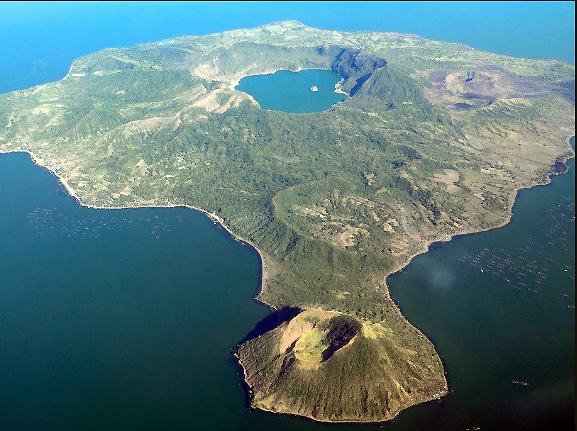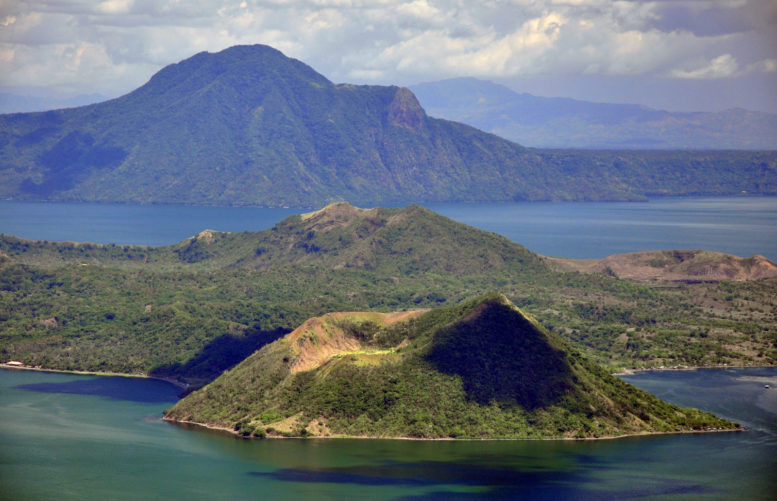The Taal Lake, also known as Talisay Lake and Bombón Lake, is a circular fresh water lake located in the Province of Batangas, in Southern Luzon with over 26,700 hectares. As a child, I frequented my great grandaunt’s house by the ridge of Tagaytay City, overlooking Taal Lake. Every year, I was awestruck by the beauty of Taal Volcano, its 1.5 km by 0.3 km crater, and the serenity of Taal Lake.
Ken Jennings reported Taal Lake was once part of the ocean a few hundred years ago. It was an arm of Balayan Bay, which opens to the West Philippine Sea. During the 18th century, a series of eruptions filled in the entrance to the inlet, isolating it from the ocean except for one narrow river. Jennings also alludes to the Taal tale that begins with the Taal peak’s current cone as an island rising out of the Lake Caldera, which is called Volcano Island. The smaller crater of Volcano Island is now filled with rainwater. Yellow Lake or Main Crater Lake is more than half a mile across, making it the world’s largest “double” lake: “It’s a lake on an island on a lake on an island.”
The Batangas locals sometimes claim that a rock outcropping from the Main Crater Lake, called Vulcan Point, is the world’s largest “triple” island: “An island in a lake on an island in a lake on an island.”
In the middle of Taal Lake sits an island called the Volcano Island. On the Volcano Island is a volcano named Taal Volcano. The volcano’s crater formed another lake (Yellow Lake/Main Crater Lake). Thus, there is a lake (the Yellow/Main Crater Lake) within a volcanic crater (Taal Volcano) on an island (the Volcano Island) in a lake (Taal Lake) in an island (Luzon).
When viewing this complexity from the Tagaytay Ridge, the Taal Volcano in Taal Lake view is one of the most picturesque locations in the Philippines.

The Main Crater. Photo Credit: Conde Nast Traveler
The Taal Volcano is the world’s smallest active volcano. It is only 1,000 ft tall. The last eruption was in October 1977. It has had 33 recorded eruptions. Volcanic eruptions of strong intensities sometime between 500,000 and 100,000 years ago formed a volcanic caldera, known as the Taal Caldera, and Taal Lake fills this caldera with fresh water.
A Caldera is a large, bowl-shaped volcanic depression. A Caldera forms when the top of a volcanic cone collapses into the space left after magma is ejected during a violent volcanic eruption. Its diameter is many times that of the original vent. The term Caldera is Spanish for Caldron.
Pia Ranada reported not many are aware that 264 years ago, Taal Volcano experienced a devastating eruption lasting almost 7 months. The 1754 eruption is to date Taal Volcano’s biggest eruption. Beginning on 15-May-1754 and ending on 5-December-1754, it buried 4 Batangas towns under ash, volcanic rocks, and water. It brought about days of ink-black darkness and changed the topography and characteristics of the Taal Volcano and lake system. Ranada further elaborated about the aftermath of the 1754 eruption stating that the nearby Pansipit River, which connects Taal Lake to Balayan Bay and the West Philippine Sea, was partially buried. River and lake waters displaced by the ejected debris submerged, not only Taal, but also the cities of Old Lipa, Tanauan, and Sala.
It has been over a hundred years since the 1754 eruption of Taal Volcano, and newer towns have since emerged. These are Talisay (1869), Cuenca (1877), Alitagtag (1910), Mataasnakahoy (1932), Agoncillo (1949), San Nicolas (1955), Laurel (1961), Santa Teresita (1961), and Balete (1969).
Laguna de Bay is the Philippine’s largest lake. Lake Lanao is the second largest, and Taal Lake is the third largest lake. Taal Lake is well renowned overseas because of two species of fish that can only be found there. These are the Maliputo (Caranx ignobilis) and the overharvested Tawilis (Sardinella tawilis). A lesser-known endemic fish species to Taal Lake are two Goby species (Gnatholepis volcanus and Rhinogobius flavoventris). The rare Garman’s Sea Snake (Hydrophis semperi) also called the Lake Taal Sea Snake, is a black and white fresh water sea snake that is only found in Taal Lake. The Bull Sharks (Carcharhinus leucas) used to be part of Taal Lake’s once-diverse ecosystem but were extirpated by the locals by the 1930s.
Sofia Alaina and Carmelita Rebancos reported in the Journal of Nature Studies that Maliputo is endemic to Taal Lake, and is a catadromous fish that breeds and spawns in estuarine waters. These waters have a mixture of marine and fresh waters and found in river mouths and mangroves. A catadromous fish lives in fresh water and enters salt water to spawn. Most of the eels are catadromous. The Maliputo spawns in Balayan Bay and its fingerlings migrate and swim upstream through the Pansipit River to seek fresh water in Taal Lake.
The Talakitok or Muslo, is a saltwater fish that is usually found in mangroves and river mouths. They are called Maliputong Labas when they are found in the Pansipit River.
The Tawilis sardine measures 15 centimetres in length and weighs less than 30 grams. Tawilis is the only Clupeidae family of fish that inhabits fresh water. A Clupeidae is a large family of soft ray-finned fishes (Isospondyli) that include the Herrings, Sardines, Shads, Menhaden, all having a forked tail. Dr. Rafael D. Guerrero III reported in Agriculture Magazine that the Tawilis is the only fresh water sardine in the world.
Of the two Gobies (Gnatholepis volcanus and Rhinogobius flavoventris) in Taal Lake, it is the Rhinogobius flavoventris that is wildly traded as an aquarium fish. The Gnatholepis volcanus is a tropical fish, which is the only marine genus that includes mostly estuary-dwelling and freshwater fish.
The Philippine Garman’s Sea Snake (Hydrophis semperi) species is only one of two “true” sea snake species that are known to live entirely in freshwater; the other sea snake (Hydrophis sibauensis) is from Sibua River, Borneo, Indonesia.
However, there are threats to the survival of Taal Lake’s indigenous fish. It is alarming that Tilapia fish cage farming is seriously threatening the existence of Maliputo fish, Tawilis sardines, and other fish that are endemic to Taal Lake.
Agriculture Magazine (March, 2018) reports about Nile Tilapia Farming in Taal Lake, Batangas, which had began in the 1980’s. Tilapia fingerlings are stocked at 50,000 to 200,000 per cage for culture periods of 6 to 8 months. Intensive feeding of the fish is done with commercial pellets that either sink or float. One result of Tilapia Farming in fish cages is massive fishkills due to poor water quality as a result of low dissolved oxygen and high levels of toxic gases in the water. There are also Milkfish (bangus) grown in fish cages. Millions of Filipinos rely on Tilapia and Bangus for food. However, the over-crowding of Taal Lake with fish cages, combined with over-crowded fish cages as well, is infamous for damaging the overall water quality, whether they are staked in the open seas, coastlines, rivers, or lakes.
The presence of the Jaguar Guapote (Parachromis managuensis) is another serious threat to the fish in Taal Lake. It is a predatory piscivorous fish native to the Atlantic waters of central and south America, including Florida, and eats other fish. The illegal introduction of this invasive species into the Taal Lake is quite unfortunate for all the fish in the lake and its tributaries. Edna Agasen, et.al. in a study published in 2008 had anticipated that this alien fish could become abundant in all areas of Taal Lake because of the lavish growth of aquatic vegetation which serves as their spawning and feeding grounds, abundant natural food, and a favorable environment. This may cause serious damage to native fish communities through direct predation.
Above all, pollution is the major threat to Taal Lake. Human waste and garbage disposal emanating from the vacation resorts and residents in nearby towns, as well as animal waste from the thriving piggery industry in the same nearby towns all resulting in fishkills, are the main sources of pollution in Taal Lake. On 30-May-2011, the Bureau of Fisheries and Aquatic Resources (BFAR) announced a fish kill of 750 metric tons. The pollution problem needs to be addressed as soon as possible to prevent endangering the fish endemic to Taal Lake, and the untimely destruction of Taal Lake’s panoramic landscape and its waters.
Protected area and management. Proclamation No. 235 declared the Taal Lake basin as the Taal Volcano National Park on 22-July-1967. Under Republic Act 7586, known as the NIPAS Act of 1992, the area was reestablished as the Taal Volcano Protected Landscape by Proclamation No. 906 on 16-October-1996. The protected area is managed by a Protected Area Management Board (PAMB). A Management Plan was crafted and approved by the PAMB in 2009 and now serves as the blueprint for lake conservation.
References:
- Jennings, Ken. “A Crater Lake in the Philippine’s with a surprising history.” Conde Nast Traveler. 21-January-2013.
- Dictionary, Merriam-Webster
- Ranada, Pia. “When Taal Volcano erupted for six months.” Rappler Newsletter. 14-May-2018.
- Alaira, Sofia A. and Rebancos, Carmelita M. “Maliputo (Caranx Ignobilis Foorskal) Fish Cage Farming practices among selected operators in Taal Lake, Batangas, Philippines.” Journal of Nature Studies. 13(2): 25-40, 2014.
- Guerrero III, Dr. Rafael D. “New Findings on the Tawilis of Taal Lake.” Agriculture Magazine. September 2015 Issue.
- Agriculture Magazine. March 2018 Issue.
- Agasen, Edna; Clemente, Julian; Rosana, Maurita: and Kawit, Nenita. “Biological Investigation of Jaguar Guapote Parachromis managuensis (Gunther) in Taal Lake, Philippines.” Journal of Environmental Science and Management. 9(2): 20-30, 2008.
